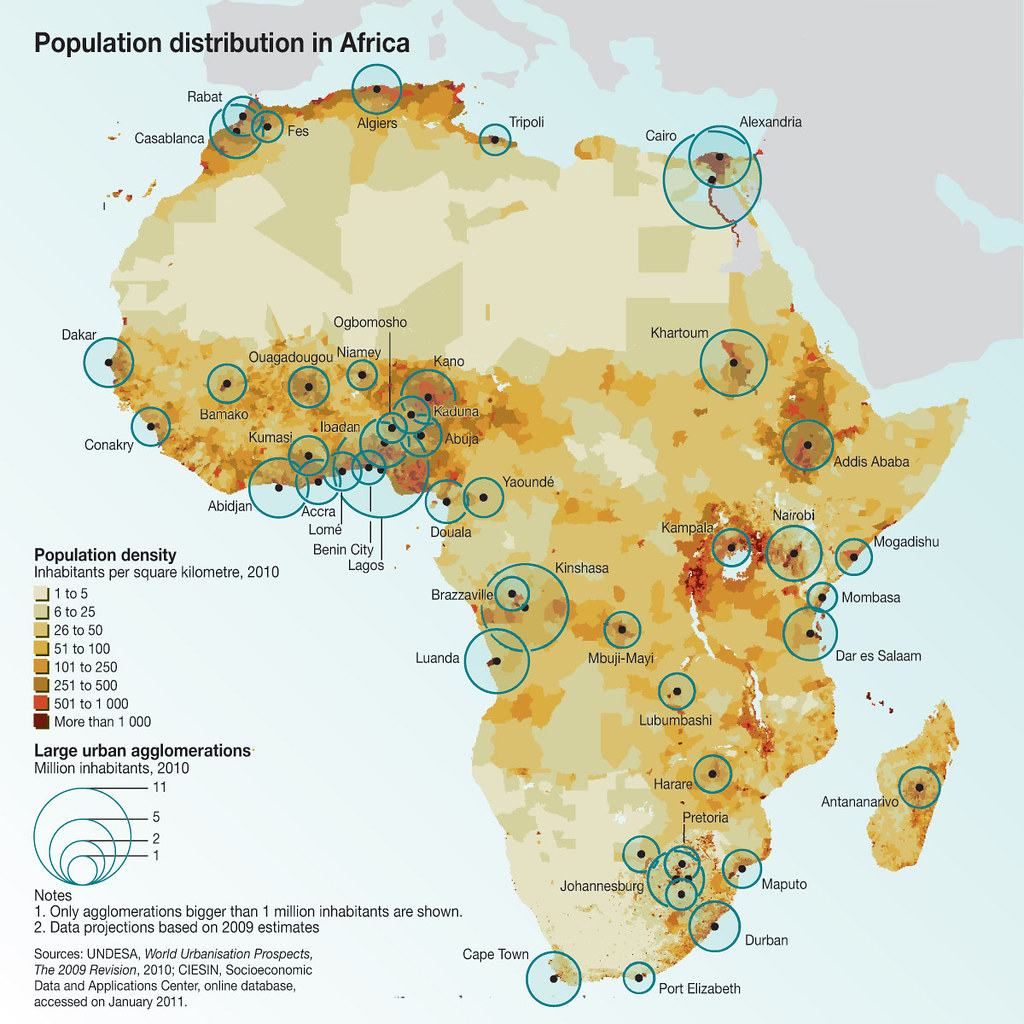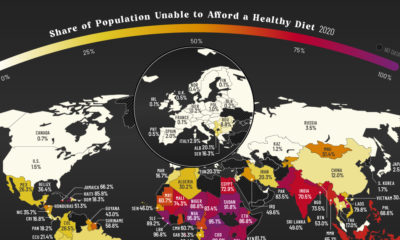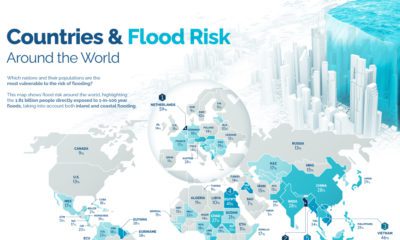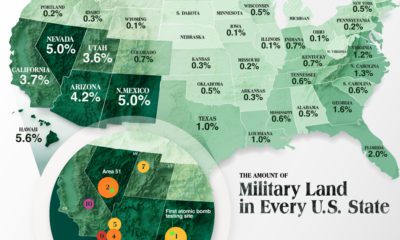One way to do this is to present data in a different way than what is traditionally expected, enabling a fresh perspective of the same information. Today’s animated map comes to us from Reddit user notoriousstats, and it provides another angle of looking at a traditional world map: by plotting countries in the order of ascending populations, from the least populated to the most populated.
Filling a Map from Scratch
In the above animation, countries are added onto the map in sequence — each must have a minimum population of 1 million people — going from Swaziland (now officially known as Eswatini) all the way up to China. It’s a visual trick that helps trigger some new insights, specifically about the population density of countries and continents. Let’s dive into a couple things that stood out.
Insights on Population Density
We naturally assume that the bigger a country is, the more people it usually has. However, when we watch an animation like this, it becomes clear that this is not often the case. In fact, many large countries appear on the map early on — taking massive amounts of geographic real estate, but with very low populations. Below is a list of the 10 countries with the lowest population densities on the planet: Using this and the map as reference, what stands out?
Africa in Focus
Africa has over 1.2 billion people living on it, so we often think of the continent as having a fairly high population density. However, if you watch the animation, you’ll notice that many of the first countries appearing on the map are African — in fact, six of the 10 least densely populated countries in the world are on the continent: Namibia, Libya, Botswana, Mauritania, Central African Republic, and Gabon.
The reason for this lack of population density lies partly in geography. We are all familiar with the vast extent of the Sahara (which makes most of Libya and Maritania desolate), but have you heard of the Namib or Kalahari deserts in the south? The Namib takes away Namibia’s entire coastline, while the Kalahari makes most of Botswana and parts of Namibia almost inhospitable.
Juxtapositions
The animated map also creates some eye-popping juxtapositions between countries, which are appearing in order of population. For example, Australia and North Korea appear in sequence. Both have about 26 million people, but Australia has a landmass that is about 63 times as large. Russia and Bangladesh are also back-to-back; Russia has 145 million people, while Bangladesh has 163 million. Yet, if Russia had the population density of Bangladesh, it would be home to 19 billion people, which is three times the current global total.
Changing Perspectives
If we always look at things the same way, it’s hard to notice something new. Each time we view a map from a different angle, it creates the opportunity to discover new insights. This same thought process can be applied to other areas of life, so that we can always be learning — and data never gets stale. on Even while political regimes across these countries have changed over time, they’ve largely followed a few different types of governance. Today, every country can ultimately be classified into just nine broad forms of government systems. This map by Truman Du uses information from Wikipedia to map the government systems that rule the world today.
Countries By Type of Government
It’s important to note that this map charts government systems according to each country’s legal framework. Many countries have constitutions stating their de jure or legally recognized system of government, but their de facto or realized form of governance may be quite different. Here is a list of the stated government system of UN member states and observers as of January 2023: Let’s take a closer look at some of these systems.
Monarchies
Brought back into the spotlight after the death of Queen Elizabeth II of England in September 2022, this form of government has a single ruler. They carry titles from king and queen to sultan or emperor, and their government systems can be further divided into three modern types: constitutional, semi-constitutional, and absolute. A constitutional monarchy sees the monarch act as head of state within the parameters of a constitution, giving them little to no real power. For example, King Charles III is the head of 15 Commonwealth nations including Canada and Australia. However, each has their own head of government. On the other hand, a semi-constitutional monarchy lets the monarch or ruling royal family retain substantial political powers, as is the case in Jordan and Morocco. However, their monarchs still rule the country according to a democratic constitution and in concert with other institutions. Finally, an absolute monarchy is most like the monarchies of old, where the ruler has full power over governance, with modern examples including Saudi Arabia and Vatican City.
Republics
Unlike monarchies, the people hold the power in a republic government system, directly electing representatives to form government. Again, there are multiple types of modern republic governments: presidential, semi-presidential, and parliamentary. The presidential republic could be considered a direct progression from monarchies. This system has a strong and independent chief executive with extensive powers when it comes to domestic affairs and foreign policy. An example of this is the United States, where the President is both the head of state and the head of government. In a semi-presidential republic, the president is the head of state and has some executive powers that are independent of the legislature. However, the prime minister (or chancellor or equivalent title) is the head of government, responsible to the legislature along with the cabinet. Russia is a classic example of this type of government. The last type of republic system is parliamentary. In this system, the president is a figurehead, while the head of government holds real power and is validated by and accountable to the parliament. This type of system can be seen in Germany, Italy, and India and is akin to constitutional monarchies. It’s also important to point out that some parliamentary republic systems operate slightly differently. For example in South Africa, the president is both the head of state and government, but is elected directly by the legislature. This leaves them (and their ministries) potentially subject to parliamentary confidence.
One-Party State
Many of the systems above involve multiple political parties vying to rule and govern their respective countries. In a one-party state, also called a single-party state or single-party system, only one political party has the right to form government. All other political parties are either outlawed or only allowed limited participation in elections. In this system, a country’s head of state and head of government can be executive or ceremonial but political power is constitutionally linked to a single political movement. China is the most well-known example of this government system, with the General Secretary of the Communist Party of China ruling as the de facto leader since 1989.
Provisional
The final form of government is a provisional government formed as an interim or transitional government. In this system, an emergency governmental body is created to manage political transitions after the collapse of a government, or when a new state is formed. Often these evolve into fully constitutionalized systems, but sometimes they hold power for longer than expected. Some examples of countries that are considered provisional include Libya, Burkina Faso, and Chad.














